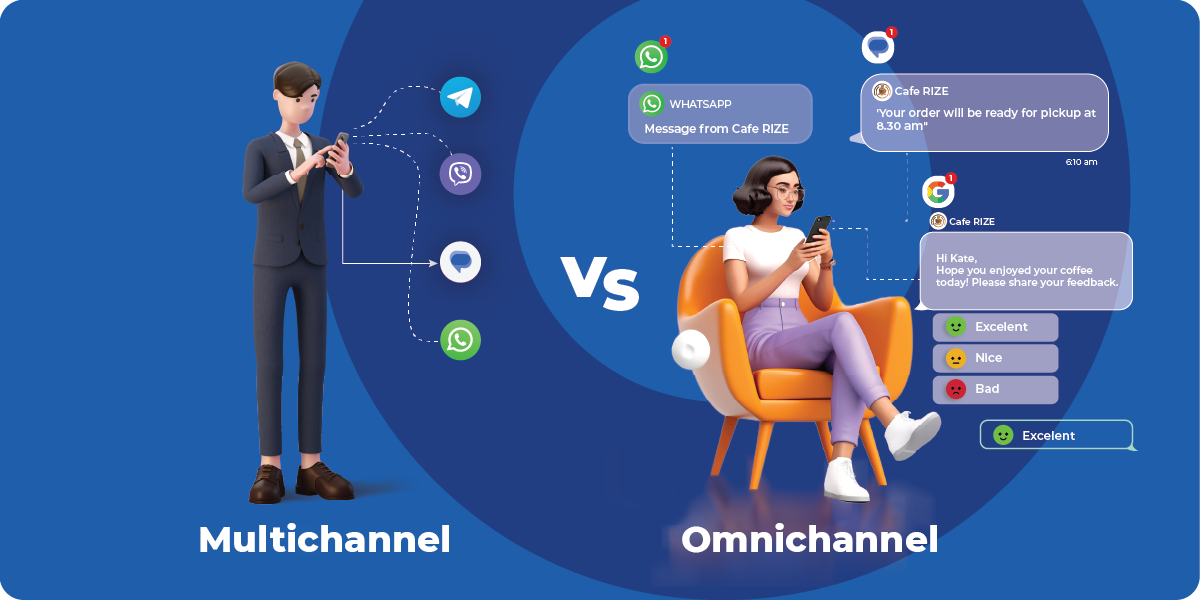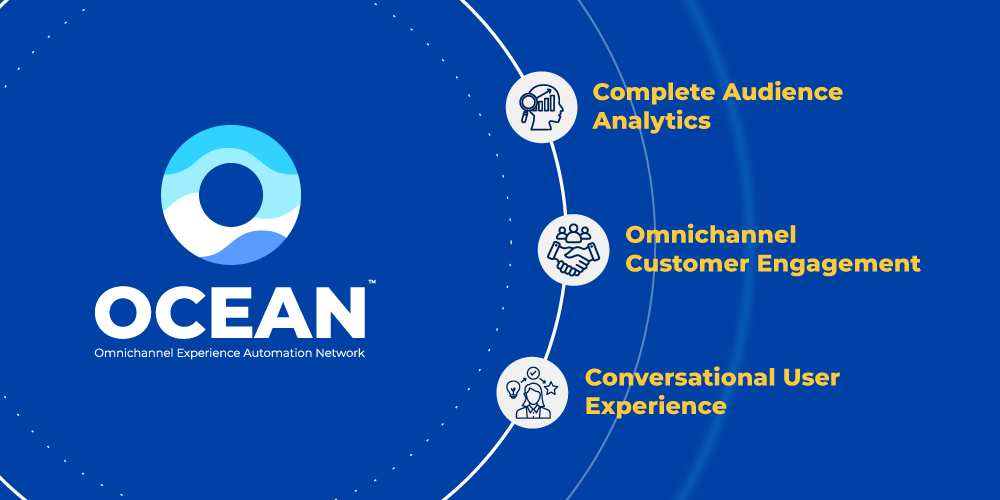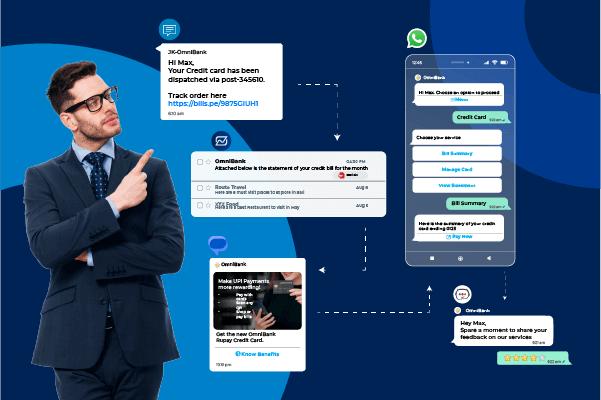
The way businesses communicate with their customers has evolved significantly in recent years. We’ve witnessed a shift from multichannel to omnichannel communication strategies. This transformation is driven by several factors like:
- Changing consumer preferences
- Advancements in technology
- Pursuit of a seamless customer experience
In this article, we’ll explore what’s propelling the shift from multichannel to omnichannel communication and why businesses are increasingly adopting this approach.
Table of Contents:

Multichannel vs Omnichannel Communication
To grasp the shift, it’s essential to differentiate between Multichannel and Omnichannel Communication:
Multichannel
- Businesses interact with customers through various independent channels
- Each channel (e.g, SMS, Email,WhatsApp, RCS, Chatbot support) operates separately, and the customer experience may not be consistent across these channels
- Leads to disjointed interactions and a lack of holistic customer understanding
Omnichannel
- Omnichannel communication takes a holistic approach. It seamlessly integrates various communication channels
- Enables customers to transition easily between channels while maintaining a consistent experience
- Data and context are shared across channels, ensuring that customers receive a unified and personalized interactions
#7 Reasons to Shift to Omnichannel Communication
Now, let’s delve into the driving forces behind the shift to omnichannel communication
 Evolving Consumer Expectations
Evolving Consumer Expectations
Consumer expectations have evolved significantly in the digital age. Today’s customers demand convenience, immediacy, and personalization in their interactions with brands. They expect to engage with businesses through the channels of their choice and they want a consistent and seamless experience throughout.
Omnichannel communication aligns with these expectations by providing customers with the flexibility to engage through their preferred channels while ensuring that the brand’s messaging and services remain consistent. As businesses prioritize meeting these expectations, they’re compelled to transition from multichannel to omnichannel strategies.
 The Proliferation of Digital Touchpoints
The Proliferation of Digital Touchpoints
The digital landscape has expanded rapidly, offering businesses a multitude of touchpoints to connect with customers. From enhanced business messaging channels to chatbot enabled web or live agent support, there’s an increasing number of channels through which businesses can engage their audience. However, this proliferation of digital touchpoints also presents a challenge on how to maintain a coherent brand presence and customer experience across all of them.
Omnichannel communication addresses this challenge by providing a framework for integrating these digital touchpoints. It allows businesses to connect the dots between their website, mobile apps, social media profiles, email marketing, and more. By creating a unified customer journey across these digital channels, businesses can strengthen their brand presence and offer a consistent experience.
 Data-Driven Insights
Data-Driven Insights
Advancements in data analytics and customer relationship management (CRM) technology have made it easier for businesses to gather and analyze customer data. These insights are invaluable for understanding customer behavior, preferences, and pain points. In a multichannel approach, these insights are often fragmented and underutilized.
Omnichannel communication leverages data-driven insights to deliver a more personalized and effective customer experience. By centralizing customer data and sharing it across channels, businesses can tailor their communications to individual customer profiles. For instance, if a customer interacts with a brand’s website and later engages on social media, the brand can use the data to provide a seamless and relevant experience.
 Competitive Advantage
Competitive Advantage
Businesses are increasingly recognizing that adopting an omnichannel approach can provide a competitive advantage. As more companies transition to omnichannel communication, those that continue to rely solely on multichannel strategies risk falling behind. An omnichannel strategy allows businesses to differentiate themselves by offering a superior customer experience—one that’s characterized by consistency, personalization, and convenience.
This competitive advantage extends to customer loyalty. Customers are more likely to remain loyal to brands that provide a seamless and enjoyable experience. As a result, businesses that prioritize omnichannel communication are better positioned to retain existing customers and attract new ones.
 Improved Efficiency and Cost Savings
Improved Efficiency and Cost Savings
Implementing an omnichannel strategy may require initial investment and adjustment, it can lead to long-term efficiency gains and cost savings. With a unified approach, businesses can streamline their operations, reducing redundancies and optimizing resource allocation.
For example, instead of maintaining separate teams for social media, email marketing, and customer service, a business can centralize these functions under an omnichannel strategy. This consolidation not only saves on operational costs but also enhances collaboration and knowledge sharing among teams.
 Enhanced Customer Support
Enhanced Customer Support
Customer support is a critical aspect of any business, and omnichannel communication significantly enhances customer support capabilities. With an omnichannel approach, customer service agents have access to a complete view of the customer’s interactions and history across all channels. This comprehensive view enables them to provide more informed and efficient support.
Additionally, customers benefit from the ability to seek support through their preferred channels, whether it’s through a website chat, social media, or phone call. This flexibility in accessing support enhances customer satisfaction and strengthens their relationship with the brand.
 Adaptation to the Mobile-First World
Adaptation to the Mobile-First World
The widespread adoption of smartphones has transformed how customers engage with brands. Mobile devices have become the primary channel for accessing information, making purchases, and interacting with businesses. An omnichannel strategy recognizes the mobile-first reality and ensures that the customer experience is seamless and optimised for mobile users.
For example, an e-commerce brand with an omnichannel approach ensures that its website is responsive and user-friendly on mobile devices, integrates mobile payment options, and provides a consistent experience across its mobile app and social media channels.
Summary
The shift from multichannel to omnichannel communication is driven by a confluence of factors, including evolving customer expectations, the proliferation of digital touchpoints, data-driven insights, and the quest for a competitive advantage. Businesses recognize that omnichannel communication is not just a trend but a strategic imperative for delivering a seamless and consistent customer experience
In order to empower brands, Route Mobile has launched OCEAN, a Personalized Omnichannel CX Suite designed to empower enterprises in fostering seamless interactions with end-users. This innovative suite ensures a unified and personalized experience across mobile, web, and social channels, revolutionizing the way businesses engage with their audience. Take the first step towards a seamless, personalized future in customer interactions —
Contact us to schedule your OCEAN demo today.





